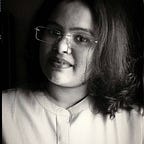My PhD. Story on mothering a thesis: Conceiving & Delivering after 38 months of labour.
Having carried four huge copies of my 190 pages Soft-laminated-bond-paper-thesis along with the soft copy in an outdated CD format — from my annexe building to the main building of the university and from the PhD section to the Thabal section, and I finally release my baby on the thickly layered dust on the table which was just like the first snow of the winter. I see my cover page titled An Autoethnography of Child Labour in Tamil Reality Television. It was like a parent looking at her daughter for one last time before she boarded her flight for doing her higher studies abroad. Now that the heaviness of the thesis is kept away and my role in the process of PhD is done with it, I swiftly drifted to my laptop in isolation to share so many things and express all those feelings that I had been building castles with.
There may be a couple of further posts in the coming days with which I would like to share my stories of the 38 months labour journey and finally let out what I kept bottling up all through these days. But to start with it all, I will need you guys to read my DISCLAIMER that occupied the first page after the title and certificate pages of my thesis. By sharing my PhD stories I dry my damped feelings under the sunlight and look forward to hearing & heal.
The following Disclaimer is from the preliminary pages of my thesis.
Disclaimer
Yes! You are reading it right. I am writing a disclaimer and I humbly insist my readers read this before getting introduced to my thesis. Disclaimers are usually statements that appear at the beginning of a work denying something — especially the usual expectations and the responsibilities. My thesis demanded a disclaimer to keep many ideal expectations at bay. This study is just not another initiative to prove to the world that child artists participating in reality television are subjected to long working hours; or that they are forced to practice day and night; that they are deprived of education; that they are exploited; or that they are pressured by the winning and losing game of the adults. Through this research, I do not intend to advise or correct the regulatory bodies. Neither am I in power to demand the media industries to adhere to the rules and regulations laid by the NCPCR or by the Child Labour Act. Keeping in mind that there are seldom genuine concerns on child artists and their future, I do not expect drastic changes to occur after reading my thesis. I am well aware that, though this study reflects the naked truth straight from the production field, it is unlikely that the usage of child artists in reality television would be banned. All the more intriguingly, I accept that, even if a miracle occurs and the capitalistic media organisations implement the ban, the parents of child artists may protest on the roads claiming that their children be allowed to showcase their talent and that it’s their fundamental right to exhibit their talents and gain popularity — just like how the whole world and its leaders and the government knew that most of cancer comes out of smoking and alcohol, but yet never takes any initiative to ban those commodities in public. It was a bitter truth to learn that most of the parents were/are aware of the consequences of public imagery and exposure to the mass entertainment world, but still, they go ahead in paving ways to keep their children in the limelight for benefits that I can list into pages. With that note, I find it essential to keep my readers informed that this is a work on child artists, including female child artists. And hence, with due respect to their privacy rights, this work presents the cases without revealing in any manner their primary, secondary and tertiary identities. As a practical researcher who has also worked in the field, I prefer refraining from high dramatic and unrealistic conclusions and prefer to plainly stick to expressing my long-hidden agony of traumatic experiences from my workplace supported with interviews from the child artists their parents, choreographers and crew members. This thesis also functions as therapeutic writing — solving my personal issues of depression, anxiety, guilt and shame that came as a gift from my decade long work experience in the Tamil television industry.
Research and the expected outcome, advancement of knowledge, becomes staid if conventions are not re-written, and if possible broken. This research seeks to redefine not only the conventions of research writing but also the modes of presentation. There is a strong need to question the relevance of the template-driven structure of presentation in the doctoral-level thesis. I think this thesis stands as a site of critical questioning of the conventions and templates. With that in mind, the conventional chapter headings such as Introduction, Review of Literature, Methodology, Discussion and Conclusion have been given a goodbye.
That’s the end of my Disclaimer and welcome to my PhD world — welcome to breaking conventions, to questioning structures and criticising presentations.
